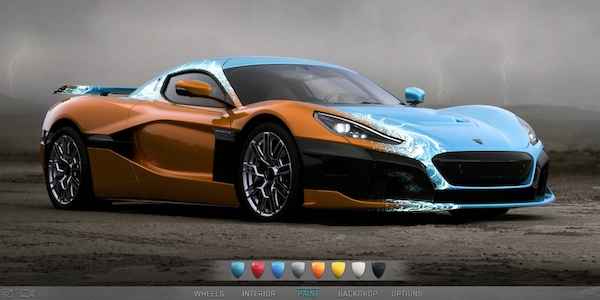Reinventing 3D Configurators
Electric vehicle company RIMAC leverages NVIDIA Omniverse™ technology to create a highly realistic vehicle configurator.

Image courtesy of RIMAC and NVIDIA.
Latest News
December 13, 2022
At the most recent NVIDIA GTC conference, electric vehicle innovator RIMAC showed off a new 3D configurator for the company's Nevera Hypercar. The solution, powered by NVIDIA Omniverse, provides realistic renderings of the vehicle in a variety of configurations – all made possible by the simulation capabilities of the NVIDIA platform and technology. By using the Omniverse Cloud offering, customers can access the solution from any device. (You can access the configurator here.) RIMAC also plans to leverage Omniverse for design and marketing activities.
The new 3D configurator allows RIMAC to preview the vehicle for customers without having to pre-render each feature or layer, which will save time and money. NVIDIA Omniverse can work with full design fidelity CAD and 3D datasets from a variety of software sources, and designers are able to work on NVIDIA-powered RTX workstations or access the platform via the cloud.
We spoke to Andrew Morris, product manager for Omniverse Manufacturing at NVIDIA, about the project.
Can you explain how the configurator project came together and how RIMAC leveraged the capabilities of Omniverse?
Andrew Morris: The core part of all of this is that we have Universal Scene Description (USD) as a single source of truth. That is what cuts across all of this. With RIMAC, we had a showreel, the vehicle was doing donuts, we had some beauty shots, some really cinematic scenes, and the same USD file was used for all those things. By getting the team to rally around Omniverse and the USD framework, you can distribute that to multiple teams and collaborate on that content without worrying about the format.
It was pretty slick. We just had a few weeks before our developer conference NVIDIA GTC to pull that together, which demonstrates how easy it is to get teams to ingest, simulate, and collaborate on their existing data. The other thing we wanted to highlight with RIMAC was the powerful nature of the visualization tools. Variants are a core part of a configurator experience – you want to change the paint color, the trim, or maybe swapout the wheels. The configurator brings that together to showcase the RIMAC vehicle.
There is also the benefit of being able to create your own lightweight user interface and viewing application based on the Omniverse platform’s development SDK called Omniverse Kit, and thanks to the extensible nature of the Omniverse platform to be able to view and create on the platform, and then build custom applications.
With a configurator, the end user is sitting at home using the most convenient device they have on hand. We used our NVIDIA Graphics Delivery Network (GDN), which was announced at GTC, to host and distribute high performance, low-latency, high fidelity advanced 3D experiences to people around the world on every device.
What can other manufacturers learn from this project, in terms of what Omniverse can bring to their applications?
Morris: That Universal Scene Description (USD) is a powerful key to unlocking today’s cumbersome manufacturing workflows. You can leverage USD to seamlessly bring coreengineering data from design and engineering, to manufacturing, through to marketing. This is unheard of today. With today’s configurators, you create 2D images of different views and options and then composite those together to create the various permutations that people may select. So you are limited in the number of permutations you can select - and you’re not able to see it fully real time ray traced, so it doesn’t look realistic, like it would when you see the product in the real world. The RIMAC configurator built in Omniverse exposes the full 3D engineering model, and you can change the materials and assets directly on that model, and then view it from any angle. If you want to introduce new options, you don’t have to create all new logic.
That creates huge efficiencies, because creating those 2D layers can be time consuming and error prone. The other key piece is being able to take advantage of Omniverse RTX enabled graphics and physics, and having that streamed to you as well for a fully interactive, intuitive, and realistic experience. We built a complete stack for that end-to-end solution.
This is not just for automotive. You can use this for any product where you want to provide a more immersive experience on a phone or tablet, or via an extended reality (XR) experience.
More Dell Coverage

More NVIDIA Coverage
Subscribe to our FREE magazine, FREE email newsletters or both!
Latest News








